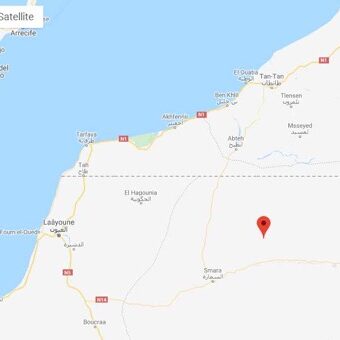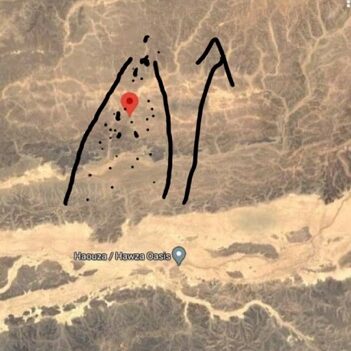1. Chwichiya 002 location
Accompanied by my Moroccan friends, I had the chance to go on the field and to record the GPS point which was used for the classification of this meteorite.
Chwichiya was discovered in Morocco in 2018 in the Western Sahara near the village of Haouza in a concentration area called Chwichiya.
2. Chwichiya 002 fall ellipse
The fall ellipse of Chwichiya 002 is about 2.5 kilometers long and 1.5 kilometers wide.
3. Description of Chwichiya 002
This meteorite is composed of many small fragments, some with fusion crust, the main mass is 158 grams. The cut surface reveals a porous, dark interior with chondrules.
This very fragile meteorite with a fusion crust was found near an habited area. This suggests that it has recently fallen to Earth. The classification indicates that it is moderately altered.



4. Scientific analysis of Chwichiya 002
Moroccans have sold this meteorite to traders under the name “CM2 Oued Haouza meteorite”. This meteorite has been resold under the same name without having done any scientific analysis. It is offered for sale as one of the last CM2 found in Morocco.
With a Moroccan friend who had also bought some, we decided to give samples to Jérôme Gattacceca of the Cerege, so that he could make precise analyses of this meteorite.
The analyses determined that this meteorite is a very rare C3.00 ung.
This classification indicates that this meteorite has a low degree of aqueous alteration, and appears to be less heated than Semarkona chondrite.
This meteorite differs from CM2 chondrites by the larger size of its chondrules.
5. Scientific discoveries
Additional analyses were conducted by different laboratories around the world.
Here are some initial findings:
Analyses conducted by Aix Marseille Univ, CNRS, IRD, INRAE, CEREGE, (Aix-en-Provence, France), Univ. Grenoble Alpes, CNRS, IPAG, (Grenoble, France), indicate a possible relationship between Chwichiya 002 and the samples returned from the C-162173 Ryugu asteroid by Hayabusa2, and the ones that will be returned from the B-101955 Bennu asteroid by OSIRIS-REx in 2023.
The University of Arizona Research, Innovation and Impact Office and the Arizona Technology and Research Initiative conducted research that resulted in the discovery of two areas with isotopic anomalies (probably organic) on a sample in NanoSIMS images, as well as six potential presolar grains.
The laboratories of the Dept. of Earth & Space Sciences, University of Washington, Seattle, WA, USA (irvingaj@uw.edu); CNRS, Aix-Marseille University, IRD, INRAE, CEREGE, Aix-en-Provence, France; Institute of Meteoritics, University of New Mexico, Albuquerque, NM, USA; 4Dept. of Earth & Planetary Sciences, Washington University, St. Louis, MO, USA, have determined a new class of carbonaceous meteorites.
This new class of meteorite is called CT3.
Chwichiya 002 will be part of it with Telakoast 001, Cimarron, NWA 6862, NWA 8781 (found near Foum Zguid, Morocco), NWA 12416, NWA 12957, NWA 13671, NWA 13984, NWA 14051, NWA 14139, NWA 14179, NWA 14200.
Scientists at the McDonnell Center for Space Science conducted a study that determined Chwichiya 002 to be among the meteorites containing a very large number of presolar grains.
Results and discussion :
A total of 32 O-rich presolar grains and three SiC grains were identified in Chwichiya 002.
Chwichiya 002 has an abundance of O-rich presolar grains, similar to the highest abundances analyzed in meteorites.
This suggests that aqueous alteration was a localized process on the original parent body of Chwichiya 002 and did not significantly affect the abundance of presolar grains.
The organic content of Chwichiya 002 is probably intrinsically lower than in typical aqueous-altered carbonaceous chondrites.
This could be due to the accretion of low-organic dust or the absence of organic formation during aqueous alteration in the parent body of Chwichiya 002.
86th Annual Meeting of the Meteoritical Society 2024 (LPI Contrib. No. 3036)






